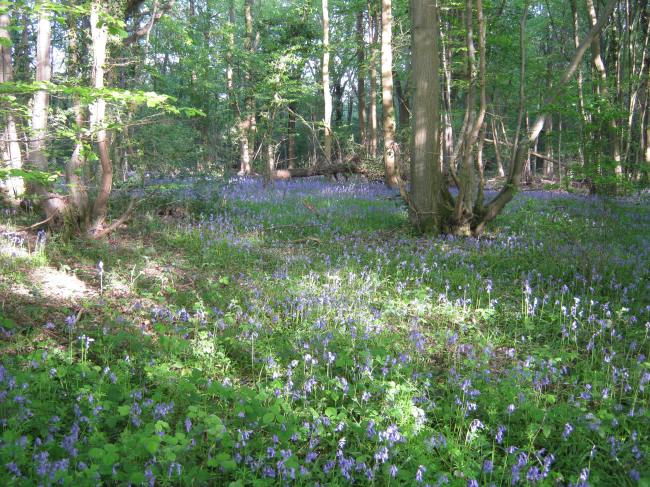Tags
bluebells, Bugle/Ajuga, Bush Vetch, coppicing, Deer fences, Early Purple Orchid, Lords and Ladies, Pendulous Sedge, primroses, Ragged Robin, Reydon Wood, Roger Deakin, Suffolk Wildlife Trust, violets, Yellow Archangel
By Friday R had recovered from his trip to Gloucestershire, so when he got home from work I suggested that we might take our postponed bluebell-wood walk that evening. He thought that would be a great idea so we set off about 6.00pm and managed to persuade E to come with us. This was a real surprise as E once got lost in Reydon Wood and hadn’t been back since. To get to Reydon Wood we usually go via the road to Southwold, our nearest seaside town, passing by the Henham Estate which is the venue for the Latitude Festival. Henham Woods were awash with bluebells so we were hopeful that our walk would not be in vain.
When we got to the entrance to the wood there were only a couple of cars parked there and plenty of room for us.
The path to the wood.
The path is usually quite interesting in itself as it runs along next to Reydon Wood on one side and fields on the other. Between the path and the wood is a very deep ditch, probably quite ancient and dug as a boundary and/or to stop deer entering the wood and damaging the trees.
It is not easy to see the depth of the ditch with this photo.
We walked a little further until we came to the entrance. The wood is excellently maintained by the Suffolk Wildlife Trust. They have started to coppice it again and have cleared away a lot of scrub. They have marked out paths through the wood and maintain the ditches. Bluebells are very sensitive plants and if their leaves are crushed they die so it is best to stick to the paths. Not only are there bluebells in this wood but many other interesting plants and trees. This wonderful habitat is also good for all sorts of animals, birds and insects too.
A bridge over a little drainage ditch.
An old coppiced tree ready for more coppicing. The word ‘copse’ for a small wood means that it was once and maybe still is a coppiced wood. There are many trees which are suitable for coppicing – hazel, ash, willow – as long as they re-shoot after their branches are cut off low they are suitable. Coppicing is similar to pollarding which is more often seen in towns where the branches are cut off near the crown of the tree. If you look to the left of the picture you will see how the paths have been marked out by laying sticks next to each other. A bio-degradable path and easily maintained too.
This is a deer fence made of brushwood. The area inside has been newly coppiced and the fence is here to stop the deer eating the new tree shoots. In Roger Deakin’s delightful book ‘Wildwood: A Journey Through Trees’ he goes coppicing with a friend and also says that some woodsmen put a heap of brushwood on each individual stump to stop deer and rabbit damage.
A couple of woodland ponds.
If anyone can tell me what the plant in the second pond is I would be very grateful. I apologise for the poor quality of the photo but I included it as I wished to show where the flowers are growing. The flowers are a little like primrose flowers and are in tiered whorls. The leaves are strap-like.
Lords and Ladies.
Early Purple Orchid.
Early Purple Orchid.
Ajuga/Bugle.
Primroses.
Violets.
Ragged Robin.
Pendulous Sedge.
Pendulous Sedge.
Bush Vetch
Yellow Archangel.
Yellow Archangel.
The next few photos are of the bluebells in Reydon Wood.




























with an injured leg and foot, I’m not able to do my long walks any more. But I just realized: I’m “walking” vicariously through your blog posts such as these! Thank you.
LikeLike
I am so sorry that you are unable to do some favourite things anymore. You sound such a brave positive woman though – I really admire you! I can’t walk as far as I’d like because of arthritis and my youngest daughter Elinor has problems with her feet and has scoliosis (curvature of the spine) too so can’t walk any distance either. A little and often is my motto!
LikeLike
Very sensible.
The more I communicate with others, the more I realize that each of us is coping with “something”. A challenge of our own.
A reader wouldn’t know from the type of posts you do that you are living with arthritis, or that your daughter has those struggles. You’re an inspiration!
LikeLike
A splendid collection of flowers.
LikeLike
We think so too!
LikeLike
So many amazingly beautiful flowers! I can see why you would want to visit this place often!
LikeLike
It is lovely and so close to home too!
LikeLike